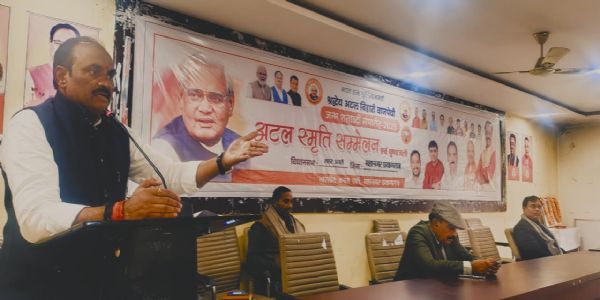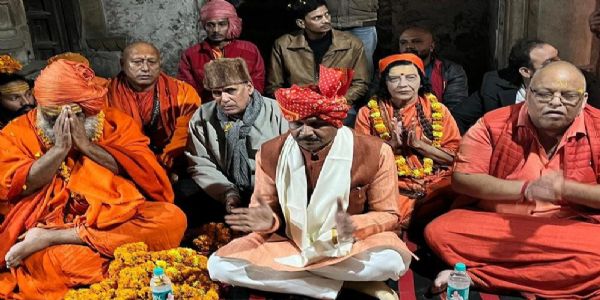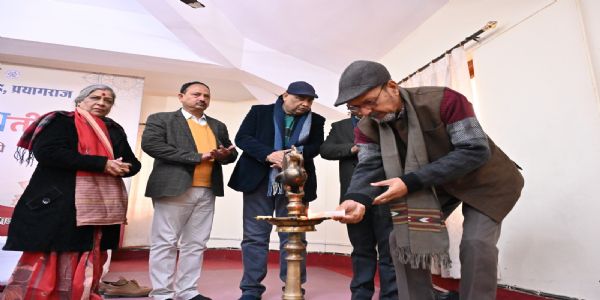
Prayagraj,
21 December (H.S.): On the second day of Bazm-e-Virasat, the event commenced on
a melodious note with a heartfelt tribute to her Guru by the renowned
Hindustani classical vocalist, Padma Shri Shubha Mudgal. She performed the
enchanting piece “Gaiye Sajana Gunijan Beech”, accompanied by Aneesh Pradhan on
the tabla, Sudhir Nayak on the harmonium, and Vrinda along with Aiya Bose on
the tanpura. The presentation of Raag Sur Sarang and a captivating Chaturang
mesmerized the audience, and the venue resounded with thunderous applause.
The
celebrated artist further enriched the evening by weaving melodies around the
poetry of prominent Hindi literary figures of the Chhayavaad era. She rendered
Nirala Ji’s evocative poem “Bandho Na Nav Is Thav Bandhu” and Mahadevi Verma’s
soulful piece “Phir Vikal Hai Praan Mere”, adding her unique musical touch.
The
highlight of the recital was her rendition of a ghazal penned by Shri Vijay Dev
Narayan during the 1978 Emergency, titled “Zameen Ke Khaakh Chhanne Par”.
Shubha Mudgal’s soulful voice brought the essence of that era alive, leaving
the audience spellbound. Her artistry illuminated the profound depth and
emotions of the ghazal, creating an enchanting atmosphere that captivated
everyone present.
EVENT
2: A Thoughtful Discussion in Memory of Fareed and Nikhat Kazmi
The
second phase of Bazm-e-Virasat began with heartfelt tributes to the late Fareed
Kazmi and Nikhat Kazmi. The session delved into three significant topics
related to cinema, bringing together insightful perspectives from prominent guests.
The
discussion commenced with a question from Irfan Sahab, who asked filmmaker
Sudhir Mishra about the future of Middle-of-the-Road Cinema. Mishra highlighted
the era of Bimal Roy and Satyajit Ray as exemplary of this genre, describing it
as a bridge between commercial cinema and parallel (art) cinema. He pointed out
that while commercial cinema often spoon-feeds its audience, parallel cinema
serves as a powerful medium for artistic expression.
Filmmaker
and actor Nandita Das emphasized that films are deeply rooted in the conviction
and commitment of their creators. She remarked that audiences ultimately
determine the type of films they wish to watch. She urged viewers to support
good cinema by watching films in theaters, ensuring that the medium does not
become limited to OTT platforms.
Remembering
Irfan Sahab’s contribution to art films, his wife and producer Sutapa Sikdar
stressed the responsibility of viewers to engage with meaningful cinema. She
added that films are not merely a source of entertainment but also a medium to
explore and connect with cultural and societal sensitivities.
Lyricist
Kausar Munir highlighted the importance of audience engagement in cinema.
Comparing 30-second reels with three-hour films, she pointed out the varying
levels of viewer involvement. Sudhir Mishra advocated for courageous
filmmaking, urging filmmakers to portray truths and realities. He suggested
that films should be made tax-free to encourage audiences to watch
thought-provoking movies in theaters.
Nandita
Das described filmmaking as a deeply personal journey for creators. She
asserted that filmmakers should have the freedom to create films in their
unique ways, confident that they would find their audience. She also emphasized
the need for government grants for cinema, as institutions like NFDC and FCII
had previously provided.
The
relationship between Literature and Cinema: The second topic of discussion
revolved around the relationship between literature and cinema. Nandita Das
remarked that literature-based films are being made, though they are often
categorized as regional cinema and not given due recognition within mainstream
Indian cinema. However, she noted a positive trend with an increasing number of
regional films drawing inspiration from folklore and literary works.
Sudhir
Mishra emphasized the importance of preserving the essence and sensitivity of
literature when adapting it into films. He highlighted the deep and
long-standing relationship between literature and cinema, stating that both
mediums enrich each other.
Sutapa
Sikdar, recalling the legacy of the late actor Irfan Sahab, highlighted the
critical role of screenplays in bridging literature and cinema. She stated that
cinema is an excellent medium for bringing literary sources to the general
public, serving as a meaningful tool for future generations.
A
Tribute to Fareed Kazmi: The session began with a tribute to Fareed Kazmi.
Irfan Sahab described him as a scholar who deeply analyzed the intricate
connections between cinema, society, and politics. A professor in the
Department of Political Science at Allahabad University, Kazmi focused on
popular (mainstream) cinema for his studies rather than parallel or art cinema.
His book “Sex in Cinema” is a pioneering work that examines the portrayal of
sexuality and gender relations in Indian films. This session provided a
platform to reflect on the evolving nature of cinema, its societal impact, and
its enduring connection with literature.
Hindusthan Samachar / Abhishek Awasthi








